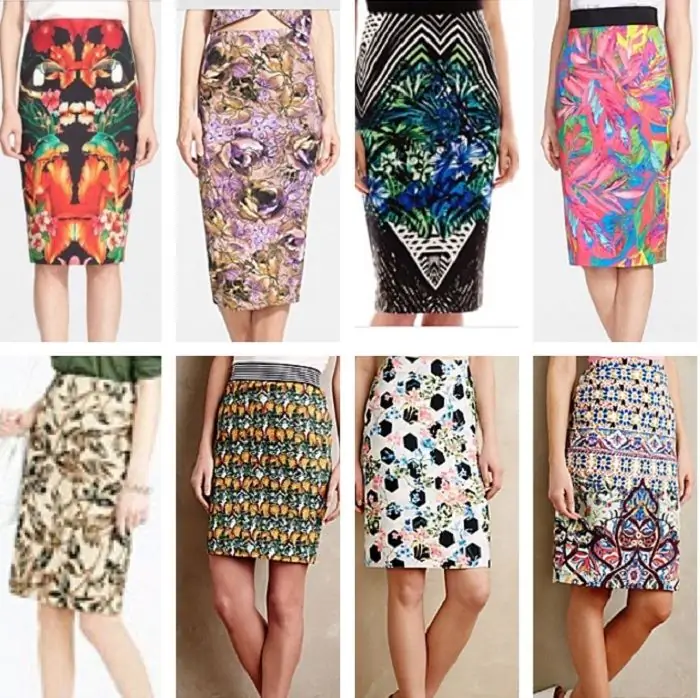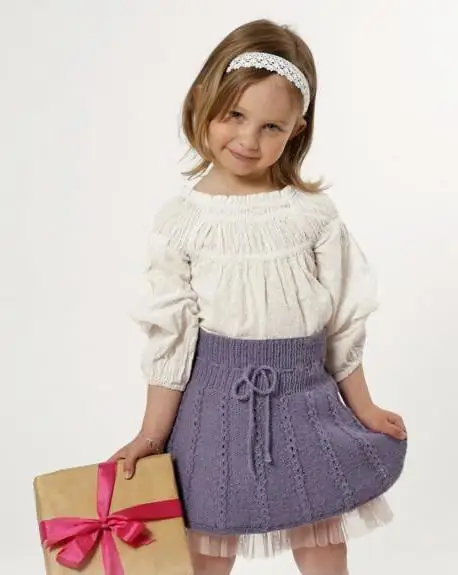
Inhaltsverzeichnis:
- Autor Sierra Becker [email protected].
- Public 2024-02-26 04:43.
- Zuletzt bearbeitet 2025-06-01 05:43.
Jede Figur kann attraktiv werden, wenn der Stil des Rocks gut gewählt ist, sagte der eminente Kenner der Modewelt Christian Dior. Wenn sich Ihre Hoffnungen auf ein Geschäft voller Modeartikel nicht erfüllen, versuchen Sie, das Problem selbst zu lösen.
Jede Näherin stellt sich schon mal die Frage: "Sollte ich nicht versuchen, selbst ein Rockmuster zu machen?". Meistens beginnt damit das erste Näherlebnis. Nach einem hervorragenden Ergebnis möchte ich wunderbare Dinge erschaffen und erschaffen! In der Garderobe erscheinen atemberaubende einzigartige Kleidungsstücke: Blusen, Kleider, Röcke. Das einfachste Muster für Anfängerinnen ist geeignet - ein Rock ohne Schlitze und Taschen.

Sei geduldig und mach weiter!
Maße nehmen, um Muster zu erstellen
Zunächst musst du eine Grundzeichnung anfertigen, die du dann weiter verwenden kannst, um andere Rockarten zu formen: zum Beispiel Bleistift, A-Linie, Godet usw.

Um eine Zeichnung eines Rockmusters zu erstellen, nehmen Sie die genauen Maße anhand der Abbildung:
- Taillenumfang (inengste Stelle);
- Hüftumfang (nach hervorstehenden Stellen);
- Rocklänge.
Sie müssen auch einen Wert wie "Sitzhöhe" anwenden - dies ist die Länge des vertikalen Segments von der Taille bis zur Hüfte (ca. 19-20 cm) und eine Zunahme der lockeren Passform (1- 2 cm).
Teilen Sie den Taillen- und Hüftumfang in zwei Hälften.
Sie haben beispielsweise folgende Ergebnisse erh alten:
- Halber Taillenumfang - 40cm
- Halber Hüftumfang - 50 cm.
- Rocklänge - 65 cm.
Papier für die Zeichnung vorbereiten: ein Blatt Tapete, Zeichenpapier etc.
Die Basis für einen geraden Rock bilden
Für den Schnitt nehmen Sie folgende Maße: OT=40 cm, OB=50 cm, DU=65 cm, Zunahmen an Taille und Hüfte um 1 cm.
Beginnen Sie mit unserer Schritt-für-Schritt-Anleitung, Ihren Entwurf zu erstellen. Das Rockmuster wird auf Papier erstellt. Bereiten Sie außerdem sofort einen einfachen Bleistift, einen Filzstift, ein Lineal, eine Schere und Klebeband vor.
Der Beginn der Konstruktion eines jeden Rocks ist die Konstruktion eines rechten Winkels mit einem Scheitelpunkt am Punkt T. Zeichnen Sie ein Segment TH, das der Länge des Rocks entspricht (65 cm). Berücksichtigen Sie die Höhe des TB-Sitzes vom T-Punkt (19 - 21 cm). Zeichnen Sie von den Punkten T, H, B Senkrechte 50 cm + 1 cm (OB + Zunahme der Hüften). T1, B1, H1 erh alten. Berechnen Sie die Länge von BB2. Es ist gleich OB + Pb / 2 - 1 \u003d 25 cm. Zeichnen Sie von T2 aus eine Linie von 1,3 cm. Lassen Sie von der erh altenen Markierung für die Seitenf alte 3,2 cm in beide Richtungen beiseite. Verbinden Sie den resultierenden Punkt nahtlos mit T - dies ist die Spitze Ihres Musters.
Berechnen Sie jetzt die Dartpfeile. Dafür gibt es eine spezielle Formel: (OB + Pb) - (OT + Fr). In Ihrem Fall stellt sich heraus (50 + 1) - (40 +1) u003d 10 cm Teilen Sie diesen Wert durch 3 \u003d 3,3 cm für die Rückwand und 6 \u003d 1,7 cm für die Frontplatte.
Finde die Tiefe der Abnäher: hinten - BB3=0,4BB2=0,425=10 cm, vorne - B1B4=0,4B1B2=0,426,5=10,6 cm.
Für eine schöne Passform des Rocks gemäß der Figur ist es notwendig, die Seitenlinien von H2 leicht um 1,5-2 cm zu verengen.

Umrande das fertige Grundmuster mit einem Filzstift mit einer dicken Linie und schneide es aus. Dies ist die Grundlage für das Modellieren von Röcken jeglicher Form.
Wirtschaftlicher Stoffzuschnitt
Die richtige Platzierung des Rockmusters auf dem Stoff führt zu einem sparsamen Verbrauch. Legen Sie zuerst die großen Teile aus - Vorder- und Rückseite, und legen Sie die kleineren dazwischen: Gürtel, Besatz, Taschen. Vergessen Sie nicht, zwischen den Mustern Platz zu lassen, um Nahtzugaben zu ermöglichen. Bitte beachten Sie, dass sie beim Modellieren eines Musters nicht berücksichtigt werden. Die Nahtzugabe hängt von der Stelle im Produkt ab. Zum Beispiel an den Seiten - von 1,5 bis 3 cm, an der Taille 2,5 - 3,5 cm, zum Biegen von unten - von 5 bis 7 cm.
Fehler unerfahrener Handwerkerinnen
Häufige Fehler beim erstmaligen Erstellen von Mustern:
- Nahtzugaben nicht vergessen! Nachdem Sie alle Teile des Musters auf den Stoff gelegt und optimal platziert haben, stecken Sie sie mit Stecknadeln fest. Kreisen Sie den Umriss mit einem speziellen Bleistift oder einem Stück Kreide ein. Kreisen Sie dann erneut unter Berücksichtigung der Nahtzugaben ein - entlang dieser Linie schneiden SieTuch.
- Darts werden nie ausgeschnitten! Sie sind einfach umrissen.
- Der Stoffverbrauch ist viel höher, wenn der Stoff groß bedruckt ist, da das Muster angepasst werden muss.
- Garnfaden nicht vergessen!
- Wenn Sie Maß nehmen, um ein Rockmuster zu erstellen, ist es besser, dünne Kleidung zu tragen oder in Unterwäsche zu bleiben.
Sie messen, normalerweise rechts. Um die Taillenlinie zu fixieren, binden Sie die Spitze so, dass sie horizontal liegt. Spannen Sie das Maßband nicht zu fest - es muss nur gut sitzen.
Empfohlen:
Röcke bauen: Anleitung für Anfänger. Maße zum Erstellen einer Zeichnung eines Rocks

Rock ist eines der femininsten Dinge, die jede Frau schmücken können. Wenn Sie einen Rock nach Ihrem eigenen Design nähen möchten, aber noch nicht wissen, wie das geht, lesen Sie diesen Artikel! Es beschreibt detailliert jeden Schritt, von der Stoffauswahl bis zur Art der Naht
Gerader Rockschnitt für Anfänger: Schritt-für-Schritt-Anleitung

Der gerade Rock ist ein Klassiker in der Garderobe jeder Frau. Der Stil des Produkts ist unkompliziert, sodass selbst ein Schneideranfänger damit umgehen kann, einen geraden Rock zu nähen. Alles darüber, wie man einen geraden Rock näht, von der Stoffwahl bis zu den Socken, erfahren Sie in diesem Artikel
Schöne und originelle Röcke für Mädchen mit Stricknadeln (mit Beschreibungen und Diagrammen). Wie man einen Rock für ein Mädchen mit Stricknadeln strickt (mit einer Beschreibung)

Für eine Handwerkerin, die mit Garn umgehen kann, ist es kein Problem, einen Rock für ein Mädchen mit Stricknadeln (mit oder ohne Beschreibung) zu stricken. Wenn das Modell relativ einfach ist, kann es in nur wenigen Tagen fertiggestellt werden
Erstellen eines Musters für ein A-Linien-Kleid mit unseren eigenen Händen

Um selbst ein Muster eines Trapezkleides zu machen, müssen Sie nicht viele Formeln und höhere Mathematik kennen. Es reicht aus, wenn Sie eine Zeichnungsgrundlage des Kleides, Papier, Schere und Bleistift zur Hand haben
Poncho: Muster mit Beschreibungen. Erstellen eines Musters eines Damenponchos

Poncho ist ein Kleidungsstück, das von den südamerikanischen Indianern zu uns kam. Seine Bequemlichkeit zieht viele an, und Sie können solche Kleider selbst nähen oder stricken
